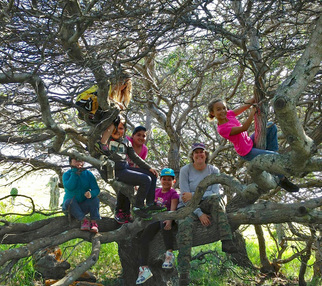
Melora Purell, the new Executive Director of Hawaii Environmental Education Alliance (HEEA), has endless passionate energy fueled by her love for Hawaii Island.
Purell began her long dance with nature in a childhood spent outdoors. “I was always in nature and had a connection with animals and plants and oceans and streams. When I was in 5th grade in Rhode Island, I would get on my bike and ride to the ocean and spend the day. I found one cave and I would collect drift wood and make little houses in the cave for my Barbie dolls and things. I never let go of that need to be in nature,” says Purell.
Purell took that love of nature with her when she embarked on a career as a science educator. After teaching for a year in Washington State, Purell traveled to Japan where she taught environmental science at the American School for nine years. Despite a language barrier, Purell was able to create environment science courses that included field work.
“I had a Japanese secretary who would make phone calls for me. I found out there was this youth hostel near the beach and so we did a marine biology course where the students went off and did field work. I also found a former faculty member whose wife was Japanese and whose family had a little farm house on this island and I took my students there for a week,” says Purell.
During vacations Purell discovered a new home on Hawaii Island. “We came to the Big Island, rented a car and drove around the whole island in one day. It was crazy. I found a job at HPA and we came and lived in the dorms for the summer and that was when I fell in love with this place, especially Kohala Mountain,” says Purell. “I've always felt at home in Hawaii. Here, living the culture means living a connection to nature in a way that I've never experienced anywhere else,” she adds.
When she first moved to Hawaii, Purell taught at Punahou on O’ahu, where she added a service component to the A.P. Environmental Education classes she taught. “When I came to Hawaii, I threw myself into all these volunteer programs because I wanted to find out what was available. The second year we made it a requirement for our A.P. Environmental Education students to do service with Reef Teach where students learned how to do monitoring on the reef. There was a restoration program at the Hee’ia wetlands and we also went with The Nature Conservancy to the Waianae Mountains,” says Purell.
After teaching for two years each at Punahou and then HPA, Purell found herself without a job and never one to stay idle long, decided on graduate school. “I used the opportunity to go to graduate school at U.H. Hilo. I was in the first cohort of the Tropical Conservation and Biology Environmental Science Program,” says Purell.
With the mysterious synchronicity that often happens when someone manages to be in the right place at the right time, when Purell finished her degree in 2006, the Kohala Watershed Partnership (KWP) was just being launched. “The first job I applied for was with the Kohala Watershed Partnership and it was completely meant to be. I was there for nine years. I was their first employee and built all those on the ground programs,” says Purell.

While at KWP, Purell worked with Three Mountain Alliance, Mauna Kea Watershed Alliance, and BISC (Big Island Invasive Species Committee), the largest non-government conservation groups on the island, “to get conservation a little more imbedded in this local government and in our local communities on the Big Island. The first [Palina] Forum we held up here at the Kahilu and there were over 200 people who came. It was very much meant to be grass roots and it was. We managed to convince all the managers and field leaders to allow their field crews to come,” says Purell.
Now as the Executive Director of HEEA, Purell is spreading her wings wide as she endeavors to implement programs that will foster citizen scientists and provide more opportunities for sustainability career paths. These are outlined in HEEA’s recently published Hawai’i Environmental Literacy Plan (HELP). The six goals identified by HELP include integrating environmental education into the schools and supporting educators with professional development, as well as raising awareness state wide and seeking funding sources.

While her passion has led Purell to take on Herculean tasks such as creating swales in the Kohala watershed to divert ocean runoff, she knows that to accomplish any of the environmental literacy goals, it takes a network. Like a fishnet thrown across the islands, Purell sees the prize catch of sustainability as a network of key people in place in regional complexes who will make a connection between the many efforts underway. “If in those complexes we have a person who is connected to the ag programs; to the organic farms; to the lo'i (taro fields); to the forest people; to the ocean folks; we can have all those local resources connected to the schools.
 RSS Feed
RSS Feed
